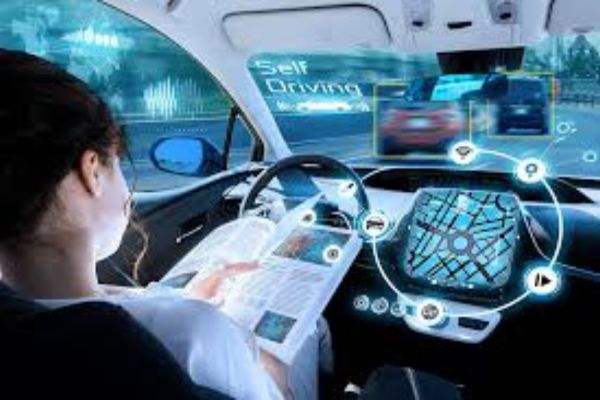The AI in self-driving cars market is driven by rising demand for ADAS, progress in AI/ML, sensor tech evolution, safety focus, and automaker investments are accelerating AI adoption in autonomous vehicles.
The self-driving car market, fueled by advancements in machine learning, computer vision, and sensor technologies, is undergoing rapid evolution. At its core, artificial intelligence (AI) empowers these autonomous vehicles to perceive their surroundings, make instantaneous decisions, and navigate safely without human intervention. AI-driven algorithms for object detection, route optimization, and predictive analysis are fundamental to this progress. This burgeoning market attracts substantial investment from established automakers, tech giants, and innovative startups all striving to enhance vehicle autonomy. Driven by increasing demand for safer and more efficient travel, coupled with favorable regulatory developments, this market is poised for robust growth, with AI serving as a cornerstone of the future of mobility.
Artificial Intelligence in Self-Driving Cars Market Trends
Shifting Consumer Preferences for Convenience and Comfort: Consumers are increasingly prioritizing convenience, efficiency, and comfort, driving the rapid growth of interest in self-driving vehicles. Autonomous travel frees up passenger time for other activities during transit. This evolving consumer behavior compels automakers to accelerate their development of self-driving technologies.
Strategic Partnerships Between Automotive and Tech Companies: Collaborations between technology firms and traditional automotive manufacturers are significantly accelerating technological progress in this domain. These partnerships bridge the gap between cutting-edge AI capabilities (as seen in companies like Waymo and Tesla) and the established manufacturing expertise of the automotive industry. This synergistic environment fosters rapid innovation and efficient resource allocation towards the realization of fully autonomous vehicles.
Escalating Investment in Research and Development: The continuous influx of investment into research and development (R&D) serves as the primary catalyst for the self-driving car market’s expansion. Significant resources are being allocated to refine AI systems, aiming to enhance the performance, safety, and overall capabilities of autonomous vehicles. Increased funding fuels innovations such as improved vehicle-to-vehicle communication and advanced navigation systems, accelerating market deployment and bolstering future prospects.
Growing Environmental Concerns and Sustainability Goals: Self-driving cars are often integrated with electric vehicle (EV) technologies, offering a pathway to reduced carbon emissions and greater sustainability. Autonomous electric vehicles (AEVs) can optimize energy consumption through intelligent driving patterns and emission reduction strategies. This aligns with global sustainability initiatives and governmental efforts to promote a cleaner environment, thereby amplifying the importance of AI in the broader movement towards greener transportation.
Expansion of Mobility-as-a-Service (MaaS) and Ride-Sharing: The significant growth of ride-sharing services and the Mobility-as-a-Service (MaaS) concept is a crucial driving force behind the adoption of AI in self-driving technology. Autonomous driving has the potential to lower operational costs and enhance fleet efficiency in shared mobility services by eliminating the need for human drivers. The integration of self-driving cars into ride-hailing platforms enables businesses to achieve cost-effective operations while providing consumers with convenient, on-demand transportation solutions.
Artificial Intelligence in Self-Driving Cars Market Segmental Analysis
Vehicle Type Analysis
- Passenger Vehicles: Currently, the primary focus of AI development in the self-driving car market is on passenger vehicles. These are designed for personal transportation and leverage AI to enable smooth and safe autonomous operation. AI functionalities such as adaptive cruise control, lane-keeping assistance, collision avoidance, and full self-driving capabilities enhance safety and passenger comfort. Companies like Tesla and Waymo are at the forefront of this segment, offering increasingly sophisticated autonomous driving systems.
- Commercial Vehicles: A growing emphasis is being placed on integrating AI into various commercial vehicles, including trucks, buses, and delivery vans, for self-driving applications. Autonomous truck technology, for instance, promises to revolutionize long-haul transportation within the logistics and transportation sectors by reducing labor costs and optimizing fuel consumption through intelligent routing and navigation. AI-powered systems also enable these vehicles to analyze traffic conditions, predict delivery times, and optimize fleet management for greater efficiency and cost savings.
- Shuttle Services: An emerging segment within the self-driving car market is shuttle services, particularly tailored for urban environments. Designed for short-distance travel, these autonomous vehicles have the potential to disrupt traditional public transportation systems by offering cost-effective, efficient, and on-demand services. AI-driven shuttles can operate on fixed, pre-programmed routes or dynamically adjust their routing based on real-time demand and traffic conditions.
Application Analysis
- Autonomous Navigation: Autonomous navigation is a foundational application within the AI-powered self-driving car market, enabling vehicles to navigate roads safely and efficiently without human intervention. AI-based autonomous navigation systems utilize data from various sensors like LiDAR, cameras, and radar to create a comprehensive understanding of the vehicle’s surroundings. AI algorithms process this sensor data to detect objects, recognize traffic signals, and plan the optimal and safest route.
- Driver Assistance Systems (ADAS): AI-powered Driver Assistance Systems (ADAS) not only enhance vehicle safety but also pave the way for fully autonomous driving through a gradual evolution. By analyzing real-time data from a suite of sensors (including radar, cameras, and sometimes even sound), AI provides drivers with intelligent assistance in decision-making. Features like adaptive cruise control, lane-keeping assistance, automatic emergency braking, and automated parking are now common in modern vehicles.
- Telematics and Fleet Management: AI-driven telematics and fleet management solutions are transforming the commercial vehicle sector within the self-driving technology landscape. These systems collect and analyze real-time data from autonomous vehicles, encompassing performance metrics, driver behavior (where applicable in semi-autonomous scenarios), and operational factors. This data empowers fleet managers to optimize routes, monitor vehicle health, and streamline overall operations for enhanced efficiency.
- Traffic Management and Systems: AI-enabled traffic management and infrastructure applications hold the potential to revolutionize urban traffic flow and optimization. Autonomous vehicles equipped with AI can coordinate their movements, contributing to reduced congestion and improved traffic efficiency. AI systems analyze real-time data from cameras, sensors, and connected infrastructure to predict traffic patterns, identify bottlenecks, and dynamically adjust traffic signals.
Artificial Intelligence in Self-Driving Cars Market Regional Analysis
The AI in self-driving cars market exhibits distinct characteristics across different regions, including North America, Europe, Asia-Pacific, and LAMEA (Latin America, Middle East, and Africa).
- North America: North America, particularly the United States, is a leader in the AI-driven self-driving car market, driven by significant investment in technological innovation and a relatively supportive regulatory environment. Key players in the region, such as Tesla, Waymo, and General Motors, are actively developing and deploying AI-powered autonomous vehicles. The region also benefits from a robust research and development ecosystem, fostering collaboration between automakers, technology companies, and academic institutions.
- Europe: Europe represents a significant contributor to the AI self-driving vehicle market, emphasizing safety standards, environmental sustainability, and technological innovation. Major European automotive manufacturers, including Volkswagen, BMW, and Mercedes-Benz, are heavily investing in AI to develop both autonomous vehicles and advanced driver-assistance systems (ADAS).
- Asia-Pacific: The Asia-Pacific region is experiencing rapid growth in the AI-powered self-driving car market, fueled by technological advancements, strong government support, and a large automotive manufacturing base. Countries like China, Japan, and South Korea are at the forefront of autonomous vehicle development. China, in particular, is demonstrating a strong commitment to AI and autonomous driving through substantial government funding and support for industry innovation.
- LAMEA: The LAMEA region is gradually emerging as a developing market for the adoption of AI in self-driving cars. Both government and private sectors are showing increasing interest in developing autonomous vehicle systems. Countries such as Brazil and Mexico are undertaking initiatives related to smart cities and improved transportation. Notably, the UAE and Saudi Arabia are making strides in autonomous vehicle technologies, with Dubai positioning itself as a hub for the development and testing of these vehicles.
Ask for more details@ https://www.cervicornconsulting.com/sample/2526
















